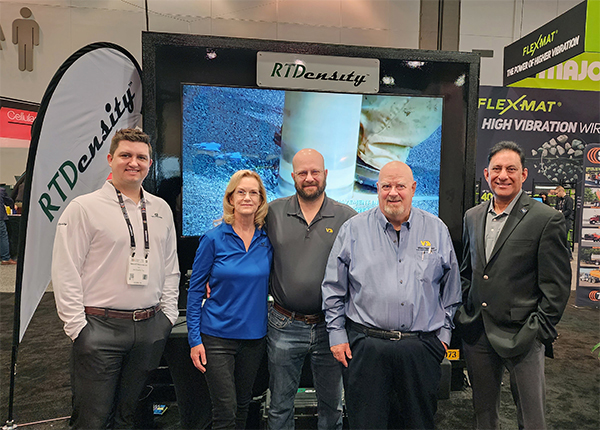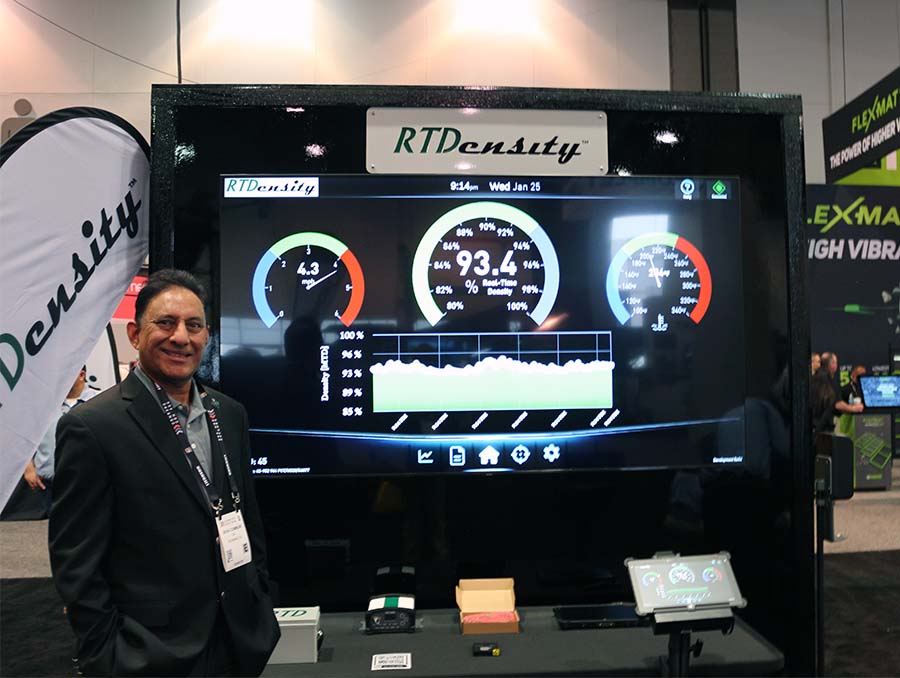A new quality-control tool for road construction developed by Electrical & Biomedical Engineering Professor Sesh Commuri debuted last week at the ConExpo-Con/Agg in Las Vegas, one of the largest construction trade shows in North America.
RTDensity, a device that will enable crews to verify pavement quality as they build asphalt roads, is manufactured by G4 Technologies, a subsidiary of the California-based construction company George Reed International (GRI), and is based on the Retrofit Intelligent Compaction Analyzer (RICA) developed by Commuri. The device should be available commercially in July or August of this year, according to Phil Reader, technical services manager at GRI.

RTDensity is a stand-alone device that can be installed on any vibratory compacter (road roller used to compact freshly-laid asphalt). The roller operator uses the device to determine the road density— a key factor that determines the performance and longevity of the road — as the road is being built. Commuri says it solves a problem in the road-construction process: currently, quality assurance is done after construction, with core samples cut out of the road and analyzed. If the core samples do not meet the required density specifications, then the contractor’s payment is reduced. In some cases, the entire road may have to be rebuilt.
A well-designed and constructed pavement is supposed to last many years. However, poor construction quality due to inadequate quality control tools is a leading cause of premature failure, such as potholes, ruts and cracks.
“Being able to detect pavement density during construction can save construction companies millions of dollars in labor, materials and time, and improve the overall quality of roadways,” Commuri stated in a paper he wrote about the device.
Laying it out
Commuri long has been interested in intelligent compaction — a compaction process that uses rollers (used for compacting soil and asphalt) outfitted with an integrated measurement system consisting of a Global Positioning System, an accelerometer (an instrument that detects and measures vibrations), a computer and temperature sensors, to estimate the stiffness of materials being compacted.
While a professor at the University of Oklahoma in Norman, Okla., in the early 2000s, he developed a neural network-based compaction analyzer, the Intelligent Asphalt Compaction Analyzer (IACA), that uses computer algorithms to estimate the density of asphalt. After joining the University of Nevada, Reno, in 2016, Commuri began working with GRI to develop what would become RICA. RICA is based on machine learning techniques and is more efficient and simpler to implement than the older IACA technology.
Commuri says that RICA, now known commercially as RTDensity, will benefit the road construction industry by
- providing continuous measurement of density and stiffness of the road during compaction and help the roller operator avoid over- or under-compaction of the asphalt pavement,
- providing complete documentation of compaction quality for hot mix asphalt (HMA) pavements that can be verified through in-situ testing,
- helping to improve productivity and efficiency while reducing operational costs, and
- providing information that can be used to plan remedial actions to improve the overall quality of the pavement structure.
The path starts here
Garrett Winkelmaier, a technology development manager at G4 Technologies and former student of Commuri’s, remembers working with his former professor in the spring of 2018 on what would become RTDensity.
“At the end of the semester, he asked if anyone had free time over the summer and could help him with a small coding project,” Winkelmaier wrote in an email. “I was the only one in the class that raised their hand.”
The two ended up working for about a year on a software application that another of Commuri’s students had developed. Eventually, they rebuilt the entire system to incorporate new technologies. Since then, Winkelmaier has worked with Commuri to build the latest software application and system of sensors as well as testing and validating. Today, he works on RTDensity at G4.
"I believe that RTDensity has the potential to change the way that quality control is handled throughout the industry,” Winkelmaier said. “Current quality control methods are destructive to the construction process, only offer a snapshot of the road at random intervals, and results often come back a day or two later when it is impossible to make changes in the construction.
“RTDensity, on the other hand, gives roller operators real-time information about the quality of the construction and can generate a report for the densities over the entire road,” Winkelmaier continued. “In general, intelligent compaction has been sought-after by this industry for over six decades, and RTDensity is the first product that addressing this need and can be purchased ‘off the shelf’ and retrofit to any steel drum roller already being used at construction sites.”
Pack pride
Commuri’s work garnered notice at the University long before RTDensity hit the market: In April 2022, Commuri was named the University’s Foundation Established Innovator for 2022.
“Sesh cares about taking his innovation from lab to market to benefit society,” Grace Chou, Chief Innovation & Commercialization Officer at the University of Nevada, Reno, said. “He actively engages with industry to find partners who not only see value in his innovation, but also commit to investing resources to bring a novel product to market.”
His work corresponds with one of the College of Engineering’s research pillars: equitable infrastructure mitigating natural hazards. Additionally, it reflects the College’s commitment to the University’s land-grant mission to provide outstanding learning, discovery and engagement programs that serve the economic, social, environmental and cultural needs of the citizens of Nevada, the nation and the world.
“We are very proud of Dr. Commuri’s contribution to industry,” College of Engineering Dean Erick Jones said. “Engineering is all about applying scientific knowledge to solve real-world problems and improve lives.”
















